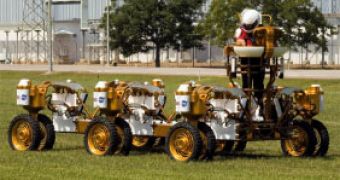NASA's new lunar rover prototype is somehow different from the Martian rovers we are familiar with today. Unlike Spirit and Opportunity, NASA's Chariot will not conduct scientific missions. On the contrary, it will be used as a 'workhorse' on the lunar surface, building roads, trenches or as a drilling rig on the Moon. The build of the Chariot was completed in the month of September last year and has been into testing ever since.
It weighs two tons and can reach a top speed of 20 kilometers per hour. The Lunar Yard at the Johnson Space Center, where the 'truck' is tested, stretches over 2 acres and consists of small hills covered with a sand and gravel mix specially made to resemble the characteristics of the lunar surface. At this moment, the bed platform of Chariot is only able to accommodate a plough, however engineers reveal that the future design could also include an excavator, a back hoe and even a drilling rig.
"Building a lunar truck isn't so much 'rocket science' as it is applying what you know about earth-bound trucks," says Lucien Junkin, Chariot's lead engineer.
Chariot is able to move with the help of six pairs of wheels, each of them having independent steering for better mobility. It has no windows, seats or doors and is driven from a rear position. Its active suspension system allows the bed of the 'truck' to descend all the way to the ground level for astronauts to climb easier into it.
The design team had much to learn from the past and current experiences with the Spirit and Opportunity rovers on the surface of Mars, as Junkin said in an interview. Although each rover lost the control of one of its six wheel, the fact that they are powered independently allowed them to continue working for the last four years in the harsh environment of Mars.
There is much to improve nonetheless. For example, its current design uses fans to cool the electric engines, big flaw considering that there is no atmosphere on the Moon. Alternatively, engineers are now trying to enhance steering response and hope to give Chariot an independent suspension system.
The Chariot concept vehicles is part of NASA's Constellation program, was designed and built in less than a year and costs about 3.5 million US dollars. According to Junkin, further tests will be conducted this year at the Moses Lase State Park, a region of steep shifting sand dunes similar to the topography of the surface of the Moon, in the state of Washington. Also, during the first two weeks, the public will have access to testings and will have a chance to view Chariot in action.

 14 DAY TRIAL //
14 DAY TRIAL //